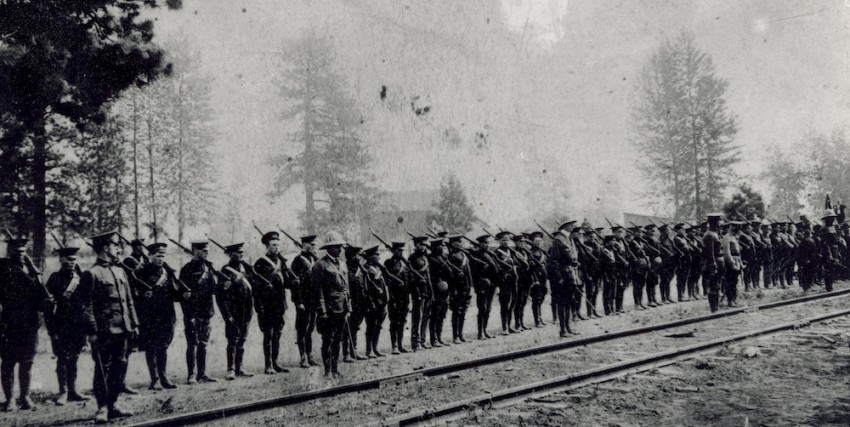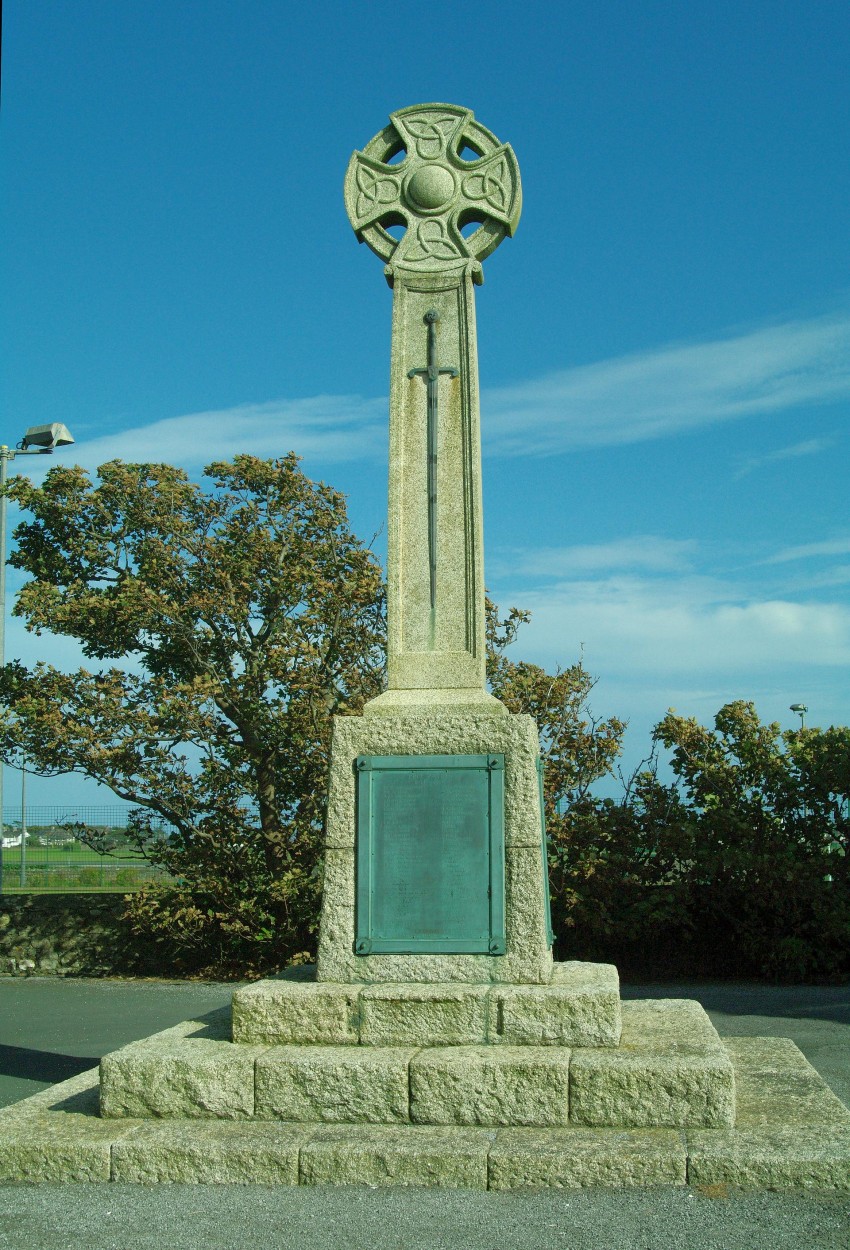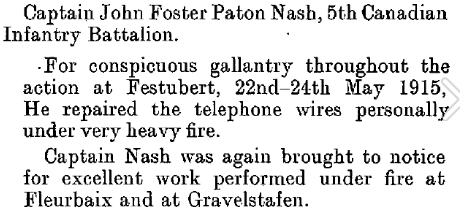#39 From Quilchena Creek to Flanders
ESSAY: For Remembrance Day 2016, Michael Sasges has reconstructed the life of Nicola Valley rancher John Foster Paton Nash.
First published Nov. 7, 2016
*
Note to Ormsby readers: I have dusted off this essay by Mike Sasges for re-use on Remembrance Day, 2020. I have rewritten the introduction, re-sized and rearranged the photos, and added some new photos. Please see here for the revised version. Thanks for your interest — Ed.
*
There are three memorials for Nash–at his school in England; in the English village where he lived briefly with his wife; and at his home in Merritt, B.C.
From an impressive array of sources, Sasges pieces together Nash’s career as a labourer, cowpuncher, ranger, rancher, fisherman, fire warden, game warden, church warden, and soldier in British Columbia between 1886 and 1914. He also touches upon Nash’s brief marriage to Eleanor Wilson. She returned to England in 1914 to be nearer her husband and she remained a war widow until her death in 1959.

In her 1958 classic British Columbia: A History, Margaret Ormsby wrote that the population of British Columbia on the outbreak of the Great War stood at about 450,000, of whom 56,000 men and women joined Canada’s war effort. In a radical reversal of the CPR-led immigration during three previous decades, the province would experience a drastic decline in population over the war years, occasioned both by enlistment and by soldiers’ families moving back to Britain — Ed.
*
By Michael Sasges
On the cenotaph in Merritt are the names of forty-four men from the Nicola Valley who died while soldiering in the Great War. J.F. Nash tops one of the three lists of names of men who died in the Great War. Nash was neither the first nor the last man from the valley to die in the Great War. He was neither the youngest nor the oldest. He is certainly the most memorable. He was good company, he kept good company, and he was well, and singularly, remembered accordingly.
He was also a brave soldier, his demonstration of competency and composure in crisis circumstances in 1915 generating a Distinguished Service Order honour.
He was not the only officer from the valley to receive a DSO, but the only officer from the valley to receive a DSO and die in the Great War.

Nash was the 5th Canadian Infantry Battalion’s signals officer. The battalion’s four days in the vicinity of the village of Festubert, in French Flanders, resulted in casualties of 61 killed, 275 wounded, and 21 missing.
“The losses of officers was 7 killed and 9 wounded, now leaving only 4 junior company officers in the Battalion,” noted the battalion’s war diary. For a time, the German opposition was only 50 yards beyond one flank of the battalion’s position and 200 yards beyond the other.
In the London Gazette (25 August 1915), the official notice of Royal favour, the report of this award reads: “For conspicuous gallantry through the action at Festubert 22-24 May. He repaired the telephone wires personally under very heavy fire. Capt. Nash was again brought to notice for excellent work performed under fire at Fleribaix and Gravelstafen.”
When he left the Nicola Valley in August 1914 for battle in Europe he left a landscape and a ranching and outdoors lifestyle he had embraced for almost thirty years, since he was 21.
John Nash was not alone. Between 1891 and 1921, about 175,000 Britons emigrated to British Columbia, perhaps 24,000 or so of them men and women like Nash, the adult children of the British upper-middle and upper classes. The numbers have been provided by Jean Barman in her article “British Columbia’s Gentleman Farmers,” published in 1984 by History Today. It concerns the gentle pretensions of the orchardists of the Okanagan Valley before the Great War – a community that was not unlike the British settlers of the Nicola Valley.
Nash first appears in B.C. in 1886 when he was in the high country back and beyond Douglas and Chapperon and Salmon lakes. Details are lacking, but he may well have been an early arrival on the newly completed C.P.R.

On 11 November 1886 “J.F.P. Nash” received a grant of land from the provincial government, a transaction recorded in a register of land grants in the Nicola countryside.
Place image 5 here.
Location and acreage are not recorded, but a place name compilation, completed by the Nicola Valley Museum and Archives, reveals that Nash’s property was lot number 722.
Nash’s residence here of almost thirty years is perpetuated in the form of Nash Creek and Nash Field. The creek, in the digital Gazetteer of British Columbia, “flows SW into Salmon River, NE of Salmon Lake.”
On Lot 722, in a cabin on a creek running through it, Nash was 4,600 miles removed from birth-family tragedy.
John Foster Paton Nash was the fourth of five children born to Thomas and Amelia Jane (née Stewart) Nash. By birth order, the children were Stewart (1856-1929), Edith, (born c. 1859), James Okey (1863-1943), John Foster Paton (1866-1916), and Amy (born 1868).

As was their mother, Stewart, Edith and James were born in Brazil. As was their father, John and Amy were born in England.
Thomas Nash was a merchant and Atlantic commodities trader. Amelia Nash was thedaughter of a bookkeeper in the Atlantic trade. Thomas and Amelia married in Brazil in 1855. “May 15: At Pernambuco, Thomas Nash, Esq., merchant, youngest son of Rev. O. Nash … to Amelia Jane, eldest dau. of James Stewart, esq., of Liverpool.” (The Gentlemen’s Magazine, August 1855).
For 300 years, the Pernambuco trade had enriched Dutch, French, British, and eventually American families and mariners and sustained a multinational merchant navy. Sugar, made from cane grown in the vicinity of Pernambuco, today’s Recife, was the outward commodity that initiated the trade.
Slaves from Africa were the originating inward cargo. Brazil abolished slavery only in 1888, the last of the Western Hemisphere nations to do so.
Thomas and his brother, Foster William Nash, and their brother-in-law, George Paton, together owned companies participating in the Pernambuco trade on both sides of the Atlantic. George Paton and Co. was located in Liverpool; Paton, Nash, and Co., in Pernambuco. Thomas quit the partnership in 1863, and his brother Foster inherited £70,000 from their father Thomas Nash – some $350,000 at the time and a substantial fortune.

In the 1861 census of England and Wales, Thomas and Amelia Nash and their children Stewart and Edith, and the children’s Brazilian nanny (a nurse), were living in Kent with Thomas’ father, Rev. Okey Nash, his wife, and two servants. Okey Nash was the vicar of Throwley in the diocese of Canterbury. He died the next year, aged 85.
The 1871 England and Wales census finds Thomas Nash both a widower and the resident of a well-to-do private asylum. He is described as a “South American merchant” suffering from “melancholia.” Fellow inmates included a West Indies merchant, a Church of England clergyman, a ship owner, a ship’s pilot, and two lawyers.
His wife Amelia Jane had died in 1868, probably while delivering Amy or from associated complications.
In the 1871 census, future Nicola Valley rancher John Nash, aged five — his mother deceased and his father in an asylum — is living with Elizabeth Margaret Nash, one of his father’s sisters.
Ten years later, the 1881 census finds 15-year-old John Foster Paton Nash a cadet in the merchant navy. In between his aunt and cadet school, he boarded for two years at King William’s College, on the Isle of Man. His older brothers Stewart and James were also KWC Old Boys.
All three brothers passed most or much of their lives outside the British Isles. James Nash (BA Oxon 1886, MA Oxon 1889), was a headmaster and prelate in South Africa, and at his death in 1943 was the subject of a short Times of London obituary. Stewart Nash died in Australia in 1929.

Meanwhile their younger brother had come to B.C. The 1891 Canada census locates 25-year-old John F.P. Nash as a “farm labourer” in the Douglas Lake subdistrict of the Yale census district.
But when he volunteered for the Boer War in 1900 he reported his occupation as “cow-puncher,” suggesting a jocular euphemism for rancher.
John Nash does not appear in the 1901 Canada census: he was probably in England on his way back from South Africa with Lord Strathcona’s Horse. Discharged in England on 16 March 1901, with rank of private, he was back in the Nicola Valley at the end of 1901.

On 2 December of that year he asked the military authorities in Ottawa to send his Queen’s Medal clasps to “My address: Quilchena, Nicola Lake, British Columbia.”
Two days before Christmas 1901 he put an $80 deposit down on 160 acres of Crown land along Quilchena Creek, which according to the BC Geographical Names Gazetteer “Flows N. into S. side of Nicola Lake.” He completed the transaction in February 1902.
At the same time he applied for another 160 acres on Quilchena Creek, due him as a Boer War veteran; he received that land in November 1902. The lot numbers of the properties suggest they were not contiguous.
The “News” column of the Merritt Herald and Nicola Valley Advocate for February 1910 reveals that Jack Nash entertained friends “at home” “at his far famed ranch, Fisherman’s Rest.”
This column inaugurates stories about Nash in the Merritt newspaper — a record of the activities and experiences, the livelihood and leisure activities that were to endear this man to a rural community.

In March 1910, Nash announced that about 100 Nicola Valley residents had applied for membership in a shooting club he had been organizing since the previous year. “With thirty or more members obtained, the government will grant one rifle and 100 rounds of ammunition for every four member,” the newspaper noted.
Already a provincial fire warden, Nash may have been broadcasting his suitability for a deputy game warden appointment; the office of the game warden issued firearms licences.
More importantly, the minister responsible for public safety in the province, Attorney-General William Bowser, was also the member of government responsible for rural placeholder appointments. Nash was a local member of Premier Richard McBride’s Conservatives, the governing party in B.C. In February 1911, Nash was elected “2nd Vice President” of the riding association.
The 1911 census finds John Foster Paton Nash, rancher and fire warden, residing in the sixteenth of twenty-one households enumerated in the 22nd sub-district of the Yale and Cariboo census district. He had a lodger living with him.
Nash was also active in the Anglican Church. In March and April 1911, he performed in two fund-raisers organized by the Ladies’ Auxiliary of the St John the Baptist (Church of England) parish in Nicola.
He and the vicar, James Thompson, arranged and performed a skit they called “Wanted, a Lady.” They were both single men and both Lancashire men, Thompson by birth and Nash by childhood residency with his Aunt Elizabeth. “The net proceeds will reach over seventy-five dollars,” noted the newspaper.
In May 1911, Nash’s horse threw him “rather violently.” Injuries to his back kept him in bed for more than a week. In June, he received a commission in the local militia regiment then being formed; in July he received a Dominion government contract to supply telephone poles between Quilchena and Nicola, a distance of nine or ten miles. As a fire warden he would have known where the best standing timber for poles – probably cedar – was found.

By 1914, John Nash was a consequential contributor, vocationally and avocationally, to the creation of those civic and civil bonds that secured strangers to each other in the wide spaces of rural B.C. He was a parishioner and “sideman,” or assistant to the churchwardens, at St John’s Church.
As a provincial fire warden and eventually as a game warden, he represented a central government authority and its policies for the management and commercial exploitation of the province’s natural resources.
He was also an officer of the local militia, the grandly named 31st Regiment, British Columbia Horse, which put him in the company of two future general officers. The first was Charles Leonard Flick (1870-1949), the first and only commanding officer of the 31st B.C. Horse. In the Nicola Valley, Flick was a merchant and newspaper editor and Justice of the Peace; in the Great War, he was a regimental and brigade commander and eventually a general officer in Mesopotamia.
The second, Harold Halford Matthews (1877-1940), was the Canadian Army’s adjutant general at his death. In the Nicola Valley he was cattleman, polo player, hospital director and fund-raiser, B.C. Horse officer, and vicar’s warden at St John’s church.
If church and regiment gave Nash a high local profile among the valley’s business and political elite, his game and fire warden work found him circulating among their opposites.
The record of mounted patrols he completed as a deputy provincial game warden in the first three months of 1914 has survived at the BC Archives. He passed his daylight hours either riding between the settlements (“30th | Patrolled round Nicola to Merritt”) or riding in the high country or backcountry.
The purpose of his patrols was to record the wildlife, and interview local woodsmen and trappers about the wildlife, and of course to check their firearms licences. He then reported in person to the Justices of the Peace located on his circuits.
He visited trapper camps, wood camps, railway-construction camps, cow camps and horse camps. When in the backcountry and the high country, he inevitably ended his day at a ranch house: “Night at Lauder’s . . . night at Quinville’s . . . night at L.L.C.C. horse ranch.”
In January 1914, he passed ten consecutive nights in the backcountry. “Snow is fairly deep in most places, and in drifts was up to the horse’s stomach,” he commented in the report on that month’s patrols that he prepared for headquarters.
“I saw several trappers, but no one seems to have had much success this year. I found several farmers without licences (Free Farmers’ Licences), and am forwarding their names to Vancouver. They asked me for licences.”
For Nash, this patrol work was the calm before an approaching storm.
His fire warden, or fireguard, work also required mounted travel. Unlike game warden work, fireguard duty was seasonal, starting in the spring and ending in the fall. The forest branch annual report for 1914 noted that guards spent April on trail and telephone-line maintenance and additions. They supervised the permitted slash-burns by loggers, farmers, and railway and road builders.

Inevitably, fire wardens were the first to either respond to reports of forest fires or to report fires and organize initial suppression efforts. As the annual reported noted, “[I]n a bad fire season . . . poor judgment on the part of an inexperienced Guard may result in the unnecessary expenditure of thousands of dollars.”
The 1914 fire season “was one of the worst in the history of the West,” the annual report observed. The Nicola Valley was not spared. “Fires Raging on the Surrounding Hills: Much Timber and Property is Being Destroyed,” reads one headline on the front page of the Merritt Herald and Nicola Valley Advocate on 14 August 1914.
But a far greater fire was starting to burn and would burst into a firestorm. “Many Enlist at First Call of Country: Local Regiment Expects to leave Sunday,” reads an August 1914 headline.
Nothing John Nash did in the valley became him more than his departure. On 17 August 1914 he got married. His bride, 29-year-old Eleanor Flora Wilson, had been in the valley since the spring of 1914, visiting one of her four sisters, Justina Geraldine, inevitably and conventionally identified in the local newspapers as “Mrs. V.H. Harbord.”
On their wedding day, Canada had been at war for thirteen days. They were married at Kamloops, their union solemnized in a Church of England ceremony.
Eleanor was the daughter and granddaughter of Church of England clergymen; Jack was the grandson of a Church of England clergyman and the brother of another. He was also a stalwart of the English Church faithful in the valley.
In all probability, Jack left the Nicola Valley for Kamloops on his wedding day, or on the previous day on one of two trains that carried members of the B.C. Horse to Kamloops. There, the first B.C. volunteers for overseas military duty were assembling and awaiting Dominion government organization of their transport out of province.

In marrying Eleanor Wilson, Jack Nash was marrying an exemplar of that too-numerous-by-half English host of unmarried women of gentle birth dependent for their succour and support on parents and siblings (and their spouses) — and in the fullness of their years, on their nephews and nieces and their spouses.
Jack was also marrying a familiar individual. His unmarried aunt of gentle birth, Elizabeth, had cared for him after his mother’s death and his father’s committal. Neither of his sisters seems to have married; his younger sister Amy Nash was a “spinster” in 1894 and 1929, the years in which she received small bequests from her Aunt Elizabeth and her brother Stewart.
Starting in October 1914 Jack, who fought as a captain but was paid as a lieutenant, assigned half his $2.60 daily pay to his wife. The Dominion government granted Eleanor Nash a wife’s separation allowance while Jack lived, and a widow’s pension after he died.
Eleanor was his sole beneficiary in the will he wrote as his battalion crossed the English Channel from England to France in February 1915.
A notation on the copy of the will in his service folder is poignantly anticipatory of Eleanor Flora’s eventual circumstances: “Copied from Pay-book, Page 14. Original left in Pay-book, and returned to Mrs. J.F.P. Nash, 2 Church Park, Whitchurch Tavistock, S. Devon.”
That would remain her address until she died, in 1959, after an eminently Victorian widowhood of more than 40 years. Her companions had been her widowed sister, who died in 1956, and their widowed mother, who died in 1936.

Jack and Eleanor Nash passed most of their brief married life apart. The train that took the first B.C. volunteers to Valcartier left Kamloops on 27 August 1914. They may have had ten days together in Kamloops as his duties permitted.
The first contingent of the Canadian Expeditionary Force arrived in the U.K. in October 1914. Eleanor returned to the U.K. later that month. They may have kept each other’s company before his battalion left for the continent. Thereafter, he was either training for battle, or in battle in Belgium or France.

Canadian officers serving in Belgium and France routinely passed their leaves in the British Isles, and the military records reveal that Jack and Eleanor had three opportunities to keep each other’s company after his battalion left England for the continent.
He was granted leave, duration not recorded, during September 1915; leave of eight days during November and December 1915; and leave in February 1916. On the first anniversary of their marriage, he was in Flanders in the trenches in the vicinity of Ypres, and she was in Whitchurch. They were probably together a month later.
There was no second anniversary of their wedding: John Foster Paton Nash died on Easter Sunday, 1916, two days after his 50th birthday, in Belgian Flanders, circumstances not recorded.
The 5th Canadian Infantry Battalion’s situation on 23 April has, however, been recorded, and it was desperate. The battalion’s war diary reveals that John Foster Paton Nash died seven days after the battalion entered the trenches and one day before it left them. It had relieved another battalion on 16 April; it |was relieved by another on 24 April.
He died on the third of four days of heavy German bombardment of the battalion’s trenches, on a day of such intensity of shot and shell that the battalion headquarters was forced to find another position.


He may have died in the presence of a visiting general officer, Louis Lipsett, officer commanding the 2nd Canadian Infantry Brigade, who “was badly shelled where Capt Nash was killed,” the brigade’s war diary reported.
Nash’s death generated a gathering of Nicola Valley residents that the Merritt Herald and Nicola Valley Advocate newspaper considered unprecedented. “Never in the history of the valley has such a congregation assembled…. From Douglas Lake to Merritt men and women from every denomination met to bear witness to the love and esteem in which they held the deceased officer, and to show their grateful appreciation of the sacrifice he had made.”
The occasion was also the unveiling, in February 1917, of a commemorative tablet in Jack Nash’s memory in St John the Baptist church. “The church was full and extra seating … had to be requisitioned.” A small settler church, St John the Baptist is still standing.
Returned soldiers, some of them wounded, provided an honour guard. “[M]any noticed with a thrill of exquisite pity that some of the boys . . . were still suffering from the trying times they had been through.”
One of them unveiled the tablet. Rev. Thompson “preached a splendid sermon” and the women of the parish “provided refreshments.”
Buried in Railway Dugouts Burial Ground, in Belgium, John Foster Paton Nash is memorialized on cenotaphs in Merritt, Whitchurch in Devonshire, and on the King William’s College campus, Isle of Man.

*

A retired Vancouver newspaper editor and reporter, and grandfather, Michael Sasges first came across John Foster Paton Nash while preparing “Colliers and Cowboys: Imagining the Industrialization of British Columbia’s Nicola Valley,” partial fulfillment of the requirements of the degree of Masters of Arts in Liberal Studies, Simon Fraser University.
*
The Ormsby Review. More Books. More Reviews. More Often.
Publisher and Editor: Richard Mackie
The Ormsby Review is a journal service for in-depth coverage of B.C. books and authors. The Advisory Board consists of Jean Barman, Wade Davis, Robin Fisher, Cole Harris, Hugh Johnston, Patricia Roy, David Stouck, Maria Tippett, and Graeme Wynn. Scholarly Patron: SFU Graduate Liberal Studies. Honorary Patron: Yosef Wosk. Provincial Government Patron since September 2018: Creative BC
“Only connect.” – E.M. Forster
